Trends in health care furniture
Hospital facilities managers need to consider many factors when selecting and utilizing furniture. Ergonomics, bariatrics, cleanability and aesthetics are among the key variables to evaluate, but so is creating a family-friendly environment for patients and visitors. The latest furniture designs also need to accommodate smartphones and related communication technologies.
An additional variable to furniture requirements has been the growth of off-site health care facilities. Designers have greater flexibility in this type of setting, according to Jocelyn M. Stroupe, CHID, EDAC, IIDA, ASID, principal, CannonDesign, Chicago. “Our firm has used furniture in these situations that may have been considered for corporate projects,” she says. “We still need to consider cleaning, infection control and ergonomics, though.”
You may also like |
| Furnishings that accommodate technology |
| Systems seek flame-retardant-free furniture |
| Selecting and maintaining hospital upholstery |
| |
In addition, Stroupe is seeing more health care space allocated to shared, collaborative work areas. “This movement is in response to reducing the square footage allocated for nonrevenue-producing space and to providing caregivers with environments that support interprofessional models of care,” she explains. “While some facilities of this type are smaller, many are, in fact, large ambulatory care facilities.”
The Compass System from Herman Miller Healthcare, Zeeland, Mich., offers a solution for health care facilities that face space restrictions or have small footprints. Designed to support the needs and activities of patients and their caregivers, Compass systems are available in 13- and 21-inch-deep versions, offering two solutions for tight spaces.
The system’s rotating work surfaces, which can be folded out of the way when not in use, can be mounted at various wall heights to support patient-caregiver communication. The system integrates such patient-centered features as storage, personal lighting and accessories, with caregiver-oriented features such as work surfaces, sinks, glove storage and technology support.
Champion Manufacturing Inc., Elkhart, Ind., began providing patient seating in outpatient dialysis clinics 20 years ago. Its furniture is now found in a wide range of freestanding, outpatient environments including dialysis, oncology and infusion therapies.
“We have several models available — even recliner models that feature 3-inch casters or decorative stationary legs if you aren’t looking to transport patients,” Lauri Waidner, Champion’s director of marketing, says. “Some models feature a push-back mechanism similar to a home recliner, while others feature a wall-hugger function that is suitable for environments where space is restricted.”
Ergonomically correct
Moving forward, increased use of technology throughout health care facilities has challenged designers to consider ergonomics to a greater degree than when caregivers were tethered to a centralized nurses’ station, says Stroupe.
“Areas are now designed with decentralized models of care, making it possible to access patient records in a variety of spaces — at the bedside, at team work areas, in exam rooms and alcoves outside patient rooms,” Stroupe notes. “Each condition must be considered for its use; for example, some furniture is designed for standing-height use and others for seated-height use.”
The V6 Wall Station from Humanscale Corp., Greenwood Village, Colo., is one example of this evolution in ergonomics. Its flexible monitor arms promote patient-caregiver interaction, and support caregivers in both seated and standing positions. The V6 can be configured with an accessory mount or rail for peripheral shelves to store gloves, wipes and other items.
Bariatrics is another factor that many manufacturers have addressed in their product lines. For example, KI Furniture, Green Bay, Wis., offers a variety of seating solutions that address the needs of bariatric patients. “Safety is the No. 1 consideration when designing and developing bariatric solutions,” says Debbie Breunig, vice president, health care. “KI’s bariatric seating safely accommodates a user weighing up to 750 pounds — addressing safety in ingress and egress along with structural integrity that visually assures the user.”
KI Furniture also addresses the issue of dignity, and designs solutions that integrate seamlessly within other furniture collections. “Universal design is the ultimate consideration — solutions that meet the needs of all users, not segregating users based on size,” Breunig adds. “KI’s Arissa is a product that best demonstrates universality in design. It is tested to accommodate users up to 750 pounds, yet it can be used comfortably by all.”
All in the family
Family-friendly furniture, designed to make families comfortable when they stay at the hospital overnight, is another major trend in new furniture designs.
One example is the Palisade Collection from Nemschoff, a Herman Miller company, Sheboygan, Wis., which is designed to create an accommodating setting within the patient room. Offering seating, technology support, lighting, storage, sleeping and work space, Palisade makes it easy for guests to talk eye-to-eye with patients, share meals, entertain themselves, check in at the office and sleep without leaving the patient’s side.
“Palisade’s design yields high functionality while minimizing its footprint,” says Dave Ruppel, Nemschoff vice president and general manager. “Built-in chargers for phones and computers allow guests to stay connected to the outside world while staying near the patient. The sofa converts into a sleep surface, the stool tucks into the day stand, and a mobile table has legs that slide under the sofa — options that let guests choose where to position themselves for conversation, comfort, work, meals or sleep.”
Steelcase Health, Grand Rapids, Mich., has designed a two-room suite that provides space for a medical exam and an adjoining space for consultation. This optimizes the appointment, with each activity taking place in an area that’s best equipped to support it. Doorways into each room, plus a walk-through between, provide multiple means of access.
“The family can wait in the consultative space until the patient has been examined, allowing for some privacy, but preventing the family from feeling excluded,” says Jason Vanderground, manager, global brand communications. “In this area, patients, families and clinicians have equal ability to connect to technology and send information via a two-way monitor.”
Looking good
Aesthetics is another key factor in designing furniture for today’s health care facilities. “There is an increased focus on aesthetics, but rather than characterize it as homelike, I would describe it as fitting with the overall design of a facility,” Stroupe says. “We see a variety of environments designed into waiting areas. They are more akin to an airport club lounge where there is café seating, lounge seating and tall communal tables to support a variety of activities. Because families are accompanying patients to a greater degree, their needs often drive the type of seating environments we create.”
Combining aesthetics with durability is the aim of manufacturers such as Kwalu, Atlanta. The company’s Trava Guest and Guest Bariatric chairs provide sleek, modern seating in hospital lobbies, waiting rooms, chapels and patient rooms. The chairs feature clean simple lines; a spacious seat and back; and angled, contemporary arms to facilitate ingress and egress.
“The bariatric version incorporates Kwalu’s Designed to Last engineering and endures rigorous testing standards to provide strength and safety for people weighing up to 500 pounds,” says Michael Zusman, CEO. “The Trava collection also includes a dining and bariatric dining chair, which promote a seamless look throughout the facility.”
Keeping it clean
By their very nature, hospitals require furniture that not only is easy to clean, but also can handle abuse. “Hospital furniture should feature cleanouts behind the seat and removable seating components to accommodate easy wipe-down. The framework should be designed with minimal cracks or crevices that can harbor germs,” says Ed Miles, director, GLOBALcare, Marlton, N.J.
Health care-associated infections (HAIs) continue to challenge the health care industry. “As cleanability is key to combating HAIs, it is important to outfit hospital environments with furniture that can stand up to daily cleaning with bleach and maintain like-new looks,” Zusman says. Designing furniture with a smooth surface also is important, as bacteria can gain a stronghold in cracks and crevices, then thrive and spread to patients and their guests.
Cleanability and durability should be considered when selecting materials, Vanderground agrees. “Hospitals are using wood more sparingly, and some fabrics used in health care incorporate antimicrobials. Vinyl and polyurethane materials are commonly used because of their inherent cleanability, as are nylons,” he says.
Grade 1 vinyls from Champion Manufacturing feature a PreFixx protective finish that offers protection from staining, abrasion, burnishing and scuffing. Because they are mildew-resistant and easy-to-clean, the material offers long-lasting protection, according to Waidner.
“Composite materials with a medical-grade faux wood finish is better than wood,” Waidner says. “Real wood can lose its finish quickly when exposed to cleaners and disinfectants and, without its finish intact, wood is porous and nearly impossible to disinfect thoroughly.”
GLOBALcare utilizes Self-Skin Urethane arm caps, which are soft to the touch and can withstand harsh chemicals and cleaners used in health care environments. “We offer wood frames and metal frames to fit the desires of the particular designer or end user,” Miles notes. Durable textiles that are moisture-proof and can withstand cleaners should be selected, he adds.
Selection focus
Ultimately, facilities managers need to consider many factors during the selection process.
The selection focus should be on multiuse products, total value/lifetime cost and furniture that can be moved easily from department to department.
Ease of use by staff, patients and maintenance crews is important as well, experts agree.
Neal Lorenzi is a freelance health care writer based in Mundelein, Ill.
Financial benefits of standardization
Standardizing furniture selections not only leads to an aesthetically pleasing and cohesive look, it also provides financial benefits. Jocelyn M. Stroupe, CHID, EDAC, IIDA, ASID, principal at CannonDesign, Chicago, notes four major benefits:
• Streamlined processing and purchasing orders
• Stronger relationships with manufacturers, which leads to better service
• Increased buying and negotiating power
• More accurate budgeting
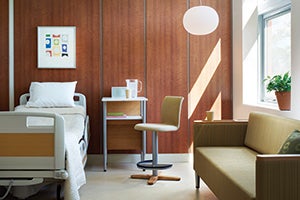 | Patient-focusedThe Palisade Collection is designed to create an accommodating setting within the patient room. |
 | Touch of technologyThe V6 Wall Station features flexible PC monitor arms to promote patient-caregiver interaction. |
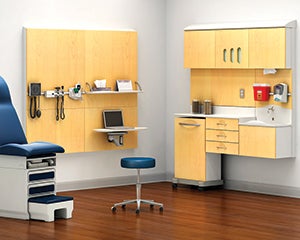 | MultifunctionalCompass is a modular system of interchangeable components for hospital and outpatient facilities that can be modified for patient rooms, exam rooms, caregiver work areas and other clinical spaces. |
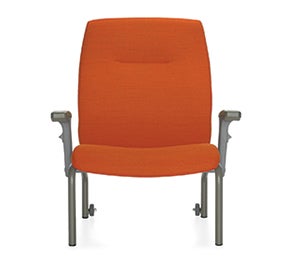 | Just rightThe Nourish Bariatric chair is designed with durable articulating arms and a high back that provide user comfort and support. |
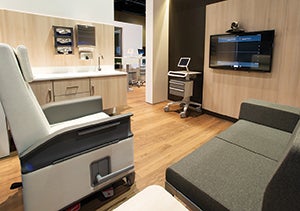 | Human touchThis two-room exam and consultation suite is designed to help people experience greater connection, empathy and well-being. |
 | Day to nightThe LaResta daybed seats four people and can convert from a sofa to a 34-by-75-inch sleep surface. Both the freestanding and built-in option offer space for storage items and bedding. |
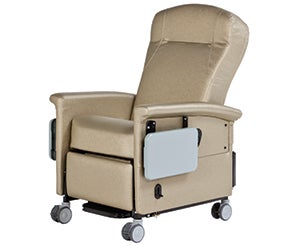 | Great movementThe Ascent II is a multipurpose medical recliner/transporter that features twin-wheel casters for easy maneuverability. |
 | Inviting areaTrava Guest and Bariatric seating create a comfortable balance in waiting rooms and other common spaces. |




